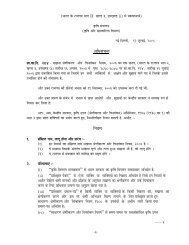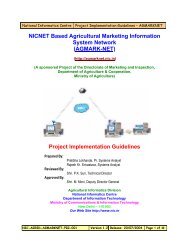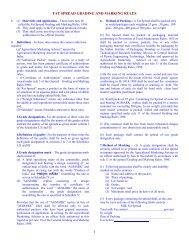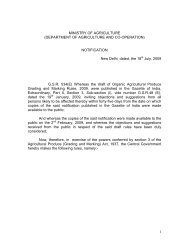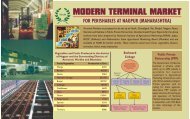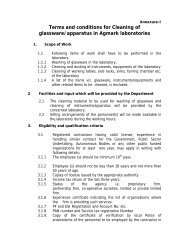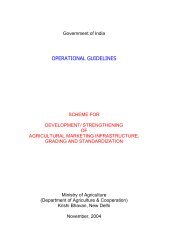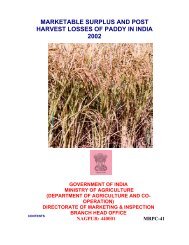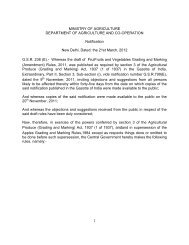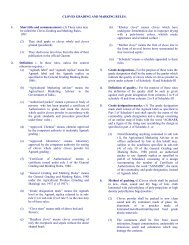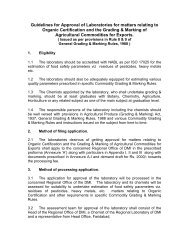Post-harvest profile of red gram - Agmarknet
Post-harvest profile of red gram - Agmarknet
Post-harvest profile of red gram - Agmarknet
Create successful ePaper yourself
Turn your PDF publications into a flip-book with our unique Google optimized e-Paper software.
Processing <strong>of</strong> Red <strong>gram</strong> is generally known as Dal milling or dehulling. Milling meansremoval <strong>of</strong> the outer husk and splitting the grain into two equal halves. Dal milling is one <strong>of</strong> themajor food processing industries in the country, next to rice milling. The efficiency <strong>of</strong>conversion <strong>of</strong> grain to Dal by traditional methods <strong>of</strong> milling is low and the resultant productespecially that from the wet method is inferior in cooking quality. The average Dal yield variesfrom 68-75 percent (theoretical value 85 percent), i.e. a net loss <strong>of</strong> 10-17 percent during theconversion <strong>of</strong> Red <strong>gram</strong> into finished Dal by traditional methods.In modernizing the Dal milling industry, the Central Food Technological ResearchInstitute (CFTRI), Mysore, has recommended an improved method <strong>of</strong> Dal milling as presentedon Chart No.2 (Page No.50).9.2 Uses:The Red <strong>gram</strong> plants and seeds are used in many ways as human food, fodder, fuel,fencing materials and maintaining soil fertility. The main uses <strong>of</strong> Red <strong>gram</strong> are as follows:Dal: Decorticated split cotyledon <strong>of</strong> whole seed is called Dal. Red<strong>gram</strong> is consumed mainly as Dal in India. Red <strong>gram</strong> Dal is astaple food and is an important ing<strong>red</strong>ient <strong>of</strong> diet <strong>of</strong> Indian people.It is also consumed as Dal in other South Asian countries, inTanzania and Uganda in Africa.Whole dry seed: Whole dry seed is boiled and consumed inEastern Africa, the West Indies and Indonesia. It is also consumedin Myanmar.Roasted and puffed seed: Roasted and puffed seeds are consumed in India.Green (Immature) seed: Used as vegetable in parts <strong>of</strong> India (mainly in Gujarat), also inCaribbean countries, in Latin American countries and East Southern Africa.Young pods: Very young pods before the seed formation cooked like beans in curriesare consumed in parts <strong>of</strong> India, Java and U.K.Seed purpose: Generally, farmers retain a part <strong>of</strong> his produce for seed purpose forsowing in next season.Animal feed: The green leaves and tops <strong>of</strong> plants are used as animal feed in South Asia,Africa and Caribbean countries. The by-product <strong>of</strong> seed coats, broken bits and powderfrom Dal mills form a valuable protein source <strong>of</strong> dairy animals. Cracked and shrivelledseeds are also used as animal feed. The husk <strong>of</strong> pods and leaves obtained duringthreshing constitute a valuable cattle feed.Fuel purpose: The dry stem <strong>of</strong> the plant and dry leaves are used as fuel for cooking bythe poor population in rural India.Fencing purpose: The dry stalks <strong>of</strong> the plant is used in fencing and in basket making.Lac culture: In China and Myanmar, the crop is also grown to culture the lac producinginsects.To improve soil fertility: Rhizobium bacteria are present in the root nodules <strong>of</strong> Red<strong>gram</strong>. The Red <strong>gram</strong> crop fixes atmospheric nitrogen in symbiotic association withRhizobium bacteria and maintains the soil fertility.55




